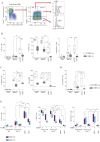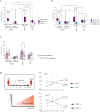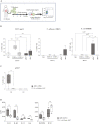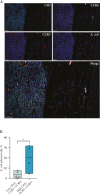An Intestinal Th17 Subset is Associated with Inflammation in Crohn's Disease and Activated by Adherent-invasive Escherichia coli
- PMID: 37462681
- PMCID: PMC10798865
- DOI: 10.1093/ecco-jcc/jjad119
An Intestinal Th17 Subset is Associated with Inflammation in Crohn's Disease and Activated by Adherent-invasive Escherichia coli
Abstract
IFNγ-producing ex-Th17 cells ['Th1/17'] were shown to play a key pathogenic role in experimental colitis and are abundant in the intestine. Here, we identified and characterised a novel, potentially colitogenic subset of Th17 cells in the intestine of patients with Crohn's disease [CD]. Human Th17 cells expressing CCR5 ['pTh17'] co-expressed T-bet and RORC/γt and produced very high levels of IL-17, together with IFN-γ. They had a gene signature of Th17 effector cells and were distinct from established Th1/17 cells. pTh17 cells, but not Th1/17 cells, were associated with intestinal inflammation in CD, and decreased upon successful anti-TNF therapy with infliximab. Conventional CCR5[-]Th17 cells differentiated to pTh17 cells with IL-23 in vitro. Moreover, anti-IL-23 therapy with risankizumab strongly reduced pTh17 cells in the intestine. Importantly, intestinal pTh17 cells were selectively activated by adherent-invasive Escherichia coli [AIEC], but not by a commensal/probiotic E. coli strain. AIEC induced high levels of IL-23 and RANTES from dendritic cells [DC]. Intestinal CCR5+Th1/17 cells responded instead to cytomegalovirus and were reduced in ulcerative colitis [UC], suggesting an unexpected protective role. In conclusion, we identified an IL-23-inducible subset of human intestinal Th17 cells. pTh17 cells produced high levels of pro-inflammatory cytokines, were selectively associated with intestinal inflammation in CD, and responded to CD-associated AIEC, suggesting a key colitogenic role.
© The Author(s) 2023. Published by Oxford University Press on behalf of European Crohn’s and Colitis Organisation.
Conflict of interest statement
MV served as a consultant to Abbvie, MSD, Takeda, Janssen-Cilag, and Celgene; and received lecturer fees from Abbvie, Ferring, Takeda, MSD, Janssen-Cilag, and Zambon. FC has served as consultant to Mundipharma, AbbVie, MSD, Takeda, Janssen, Roche, and Celgene; received lecture fees from AbbVie, Ferring, Takeda, Allergy Therapeutics, and Janssen; and received unrestricted research grants from Giuliani, SOFAR, MS&D, Takeda, Pfizer and AbbVie. All other authors have no conflicts of interest to declare.
Figures






References
-
- Uhlig HH, Powrie F.. Translating immunology into therapeutic concepts for inflammatory bowel disease. Annu Rev Immunol 2018;36:755–81. - PubMed
-
- Biancheri P, Di Sabatino A, Ammoscato F, et al. . Absence of a role for interleukin-13 in inflammatory bowel disease. Eur J Immunol 2014;44:370–85. - PubMed
-
- Brand S. Crohn’s disease: Th1, th17 or both? The change of a paradigm: New immunological and genetic insights implicate th17 cells in the pathogenesis of crohn’s disease. Gut 2009;58:1152–67. - PubMed
-
- Kastirr I, Maglie S, Paroni M, et al. . Il-21 is a central memory t cell-associated cytokine that inhibits the generation of pathogenic th1/17 effector cells. J Immunol 2014;193:3322–31. - PubMed

